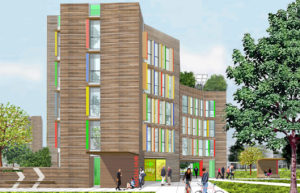Where will you live?
The question “where will you live?” formulated to an architect can’t help becoming “where will we be able to live?”, even if the future is now: it includes our private space (our home) and our social space (cities, residential areas, natural environment).
The confinement to our private space due to the need to fight the pandemic and the drastic interruption of most activities we were used to have revealed strongly negative aspects like the sensation of lost freedom and the reduction of vital space, and that is on top of the disastrous socio-economic effects; they have also drawn our attention to other aspects though, which we should necessarily consider if we want to try to formulate a plan to generate a better future for our life and what surrounds it.

Maurizio Trovatelli.
The thriving of trees, plants, flowers, the quick reclaiming of spaces by wild animals, the restored cleanliness of air and water have proven that the natural environment is able to regenerate itself when it’s not violently attacked by human activities. The pleasure most of us have felt at this rebirth has confirmed the benefit, often underrated, that the beauty of nature and of its forms, but also of artificial forms like art, architecture, writing and music brings to our lives.
The loss of socialisation, exasperated by the confinement and dramatically expressed in behaviours like singing from windows or participating in one of the many flash mobs organised, has shown how – in spite of technological surrogates and social media – it necessarily implies a direct connection between people. And I’d personally say with animals as well.

Where will I live?
In a city, or in a residential area, where travelling is limited in terms of both the distance to cover and the need to travel; therefore a place where the traffic of mechanical services is drastically reduced and what we need is closer to us. This entails a reintegration between places designed for working, for relaxing and for living, which in recent times have been placed further and further away from each other as a result of obsolete urban planning unable to read the evolution of society and productive technologies. In this new ‘urban compactness’, the offer of cultural services, places for sharing, social laboratories, natural spaces will have to manage to oppose the current phenomenon of ‘consumerism at all costs’, which is greatly contributing to the gradual increase in pollution, both physical in the environment and mental in people, and to the exponential growth of congestion, of travelling, and – quite heavily – of social conflict.
Obviously, this will be possible only if the environment of this new civic form abounds in quality services because it is the fruit of a common project involving architects, artists, sociologists, psychologists (also psychologists of place, a discipline successfully practised in France) and not the result of almost exclusively financial or stylistic advertising logics (and I would also add that opposing and limiting consumerism forces a rethinking of what and how to produce and what and how to buy…).
Buildings will have to reduce the density of the land area they occupy by extending vertically or containing green and public areas within themselves. In any case, every building or group of buildings will have to include unconventional dwellings, common spaces managed by residents, neighbourhood commercial services, spaces for culture and free time, natural and botanical green areas provided with the equipment to enjoy and maintain them. Also important will be the visual and sensory compenetration between inside and outside space.
Housing units will have to allow for the carrying out of extremely diverse activities with minimum increase in occupied area compared to conventional similar ones. Two are the viable options: relocating some of the functions to common integrative spaces within the building itself or making possible the immediate temporary transformation of the unit through the use of mobile walls and modifiable and reversible furniture solutions.
For all this to happen, people need to mentally, culturally and civilly evolve. And that’s how we get to the notion strongly expressed by Cittadellarte and Michelangelo Pistoletto: art as cure for social innovation.
I haven’t mentioned sustainability, which is a fundamental condition and must be all-encompassing. But to talk about it properly there’ll have to be a dedicated opportunity.

